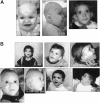Large-scale deletions and SMADIP1 truncating mutations in syndromic Hirschsprung disease with involvement of midline structures
- PMID: 11595972
- PMCID: PMC1235547
- DOI: 10.1086/324342
Large-scale deletions and SMADIP1 truncating mutations in syndromic Hirschsprung disease with involvement of midline structures
Abstract
Hirschsprung disease (HSCR) is a common malformation of neural-crest-derived enteric neurons that is frequently associated with other congenital abnormalities. The SMADIP1 gene recently has been recognized as disease causing in some patients with 2q22 chromosomal rearrangement, resulting in syndromic HSCR with mental retardation, with microcephaly, and with facial dysmorphism. We screened 19 patients with HSCR and mental retardation and eventually identified large-scale SMADIP1 deletions or truncating mutations in 8 of 19 patients. These results allow further delineation of the spectrum of malformations ascribed to SMADIP1 haploinsufficiency, which includes frequent features such as hypospadias and agenesis of the corpus callosum. Thus, SMADIP1, which encodes a transcriptional corepressor of Smad target genes, may play a role not only in the patterning of neural-crest-derived cells and of CNS but also in the development of midline structures in humans.
Figures




References
Electronic-Database Information
-
- GenBank, http://www.ncbi.nlm.nih.gov/Genbank/ (for BAC RPCI-11 95O9 [accession number AC010130])
-
- Genome Database, The, http://gdbwww.gdb.org/ (for primer sequences)
-
- Online Mendelian Inheritance in Man (OMIM), http://www.ncbi.nlm.nih.gov/Omim/ (for HSCR [MIM 142623], SMADIP1 [MIM 605802], and Goldberg-Shprintzen syndrome [MIM 235730])
References
-
- Cacheux V, Dastot-Le Moal F, Kääriäinen H, Bondurand N, Rintala R, Boissier B, Wilson M, Mowat D, Goossens M (2001) Loss-of-function mutations in SIP1 Smad interacting protein 1 result in a syndromic Hirschsprung disease. Hum Mol Genet 14:1503–1510 - PubMed
-
- Eisaki A, Kuroda H, Fukui A, Asashima M (2000) XSIP1, a member of two-handed zinc finger proteins, induced anterior neural markers in Xenopus laevis animal cap. Biochem Biophys Res Commun 271:151–157 - PubMed
-
- Lurie IW, Supovitz KR, Rosenblum-Vos LS, Wulfsberg EA (1994) Phenotypic variability of del(2) (q22-q23): report of a case with a review of the literature. Genet Couns 5:11–14 - PubMed
Publication types
MeSH terms
Substances
LinkOut - more resources
Full Text Sources
Molecular Biology Databases
Research Materials

